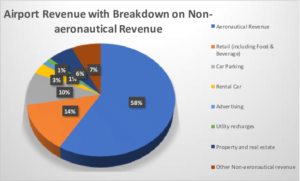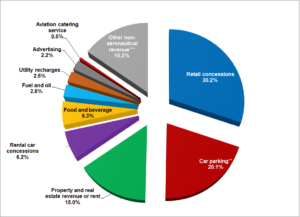
Building airport is capital intensive and maintaining it is challenging because its regulation follows international standards and so far, many airports in Nigeria cannot generate enough revenues to sustain their operations. Chinedu Eze writes that novel strategies must be adopted to make airports profitable to justify the huge investments on their establishment.
Many state governments that built airports did not envisage the huge amount of money they would deploy every month for their maintenance. When they face that challenge they become flustered and start begging the Federal Airports Authority of Nigeria (FAAN) to take them over. FAAN has taken over many state owned airports. The airports that are generating revenue that can sustain them are Uyo international airport, where the state government has lofty aviation programme, which include maintenance facility, an airline and a future hub for the West Coast connecting the Equatorial region and Central Africa.
Asaba Airport was concessioned last year by the Delta State government and it is generating revenues to sustain itself. The newly built Anambra Sate Airport at Umueri, broke record for recording high load factor for airlines the first week they started operations to that destination. The FAAN has taken over or about to take over the airports at Osubi in Warri, the ones in Dutse, Bauchi, Gombe and Kebbi.
Bayelsa just completed its airport and United Nigeria Airlines has been operating there. Ogun is undertaking ambitious cargo airport and Ebonyi has advanced the completion of its own airport. How can these airports be made viable? It is also noteworthy that even many of the airports already under the management of FAAN are not financially viable.
FAAN manages about 21 airports, which include the airports in Kano, Port Harcourt, Abuja, Maiduguri, Kaduna, Calabar, Enugu, Owerri, Jos, Sokoto, Yola, Benin, Minna, Ibadan, Akure, Makurdi, Katsina, Ilorin, Zaria and Osubi airports. Out of these airports, the Murtala Muhammed International Airport, Lagos generates the highest revenue, followed by the Nnamdi Azikiwe International Airport, Abuja. The revenues generated by these two airports are used to fund the others, except perhaps, the Port Harcourt International Airport, Omagwa, the Sam Mbakwe International Cargo Airport, Owerri, the Aminu Kano International Airport, Kano, the Benin airport and the Akanu Ibiam International Airport, Enugu.
Revenue Generation
Last week, the League of Airport and Aviation Correspondents (LAAC) held its 26th annual seminar in Lagos with the theme: “Sunset Airports-the Safety and Economic Implication.” Stakeholders who attended the seminar spoke on various ways airports can be made to generate more revenue for self-sustenance and for profit. But looking at the reality of sunset airports, which refers to airports that are shut down by 6:30 pm; that don’t operate in the night, there are many consequences of such airports. The major factor is that airlines cannot operate there after dusk. This means that in scheduling, they must adjust their services to coincide the time service is allowed at the airport.
But THISDAY investigation revealed that often, operating aircraft might encounter delays in its services to other routes, so a flight that might be scheduled for 4:00 pm to a sunset airport may be delayed till 6:00 pm and the airline would have no choice than to cancel the flight. So airlines cancel flights often because of sunset airports. Industry insiders blame airlines for what they described as improper scheduling but in a hostile operating environment, where VIP movement could delay flight for one hour without prior notice, a nonplussed scheduler knows that he has only 12 hours out of the 24 hours a day to schedule his flights. He faces a dilemma. The aircraft ought to be flogged for about 18 hours in day, but in Nigeria he could only get eight hours or less. Industry experts posit that aircraft underutlisation has its technical consequences on maintenance and life span of the equipment.
So operating for longer hours could give the airport more revenue. But FAAN Managing Director, Capt Rabiu Yadudu, recently said it would be financially challenging to operate beyond 6:30 pm to daylight airports because traffic to such airport may not justify such expenditure. But beyond aeronautical revenue, there are many things that can be done at an airport to drive more revenue.
The Chairman of the 26th LAAC Conference who is also the Group Managing Director of Finchglow Holdings, Mr. Bankole Bernard, explained that some factors determine if an airport should operate for 24 hours or not.
“Some of these factors include the traffic on the route, the cost of operations, sustaining business within the airport, the operations, navigational equipment and a long list of other factors. Having considered this, should all major airports in Nigeria operate 24 hours daily? I don’t think so. To drive this thought further, there are a few more important questions to ask. The first is, what level of traffic does the proposed 24 hours airports record annually? How many domestic airlines in Nigeria have schedules for 24-hour operations?

“What is the economic impact of operating for 24 hours? Who bears the cost of operations? Should FAAN decide to make provisions for 24 hours operations on these routes, are the airlines able to pay for these services, and has there been any intentional effort to drive traffic to our airports such as creating non-aeronautical sources of revenue like cinemas, amusement parks and other attractions around the airports?” Bernard asked.
Recommending what should be done to make an airport viable Bernard said: “We can start with the modernization of airport terminals with shopping malls. This will contribute to the commercial viability of the airports and other necessary infrastructures like the Internet and constant power supply to support businesses. We must begin to think of an alternative power supply like renewable energy to keep the airport functional and reduce the cost of operation in the long run.
“This will also make the airport viable and attractive. Another area to consider is providing affordable hotels, which will give credence to investments. The ability to provide BnB (Bed and Breakfast) hotels around the terminals of some of these airports will be of great attraction and will increase the viability of the airport as well. Lastly, there is the area of interconnectivity within the airports. The interconnectivity of the local airports to the international airports will contribute to the economic viability of these airports. It will also bring the connection to such airports; hence it will not be limited to one drop-off and pick-up.”
Huge investment
There have been criticisms against governors building airports, which is capital-intensive investment. Some industry stakeholders say that agrarian states without robust finances will earmark huge amount of money and build airports, insisting that such airports serve the elite at high opportunity cost of providing, for example, potable water, electricity, inward roads that could connect the rural communities to the cities for the movement of farm produce.
But travel expert, Ambassador, Ikechi Uko, posited that building airports is good because it enhances easy and fast movement and the more states are connected by air the better. Former Group Managing Director of Ethiopian Airlines, Tewolde Gebre Mariam had stressed that with four kilometer runway, a city could connect to the rest of the world. Ambassador Uko noted that investors do not like to travel by road; they like to travel by air, which is faster. For example, a foreigner who wants to invest in farming in Taraba would be happy if he could fly to Taraba state to inspect the farms but would be discouraged if he cannot get there by air.
At the 26th LAAC seminar, Ambassador Uko, during the panel discussion also remarked that aviation should not exist without tourism and entertainment, noting that tourism and entertainment bring people together so an airport with a hotel and shopping mall would become a rendezvous that could enhance revenue for the airport. He recalled that at the Owerri airport, the state government had built cargo facility that remain unutilized and noted that converting some of the structures to a hotel and mall could enliven the airport and bring in people who would spend their money there, pay for the gate fee and pay for car park. That way, the airport would be generating non-aeronautical revenues, while electricity from the mall and hotel powers the airport. As more people come to the airport advertisers will be attracted to place advert billboards at the airport premises, which would be enormous income to the airport.
Infrastructure Challenge
One of the speakers at the 26th LAAC seminar and the Chief Operating Officer of Ibom Air, Mr. George Uriesi, spoke about the cost of daylight airports to the airlines. Many airlines have to cut short their operations to these airports because they do not have landing facilities. For an aircraft that ought to operate for 18 hours, these airports shorten the operating hours of this equipment because of lack of night landing infrastructure.
Even some airports that have airfield lighting that enables aircraft to land in the night, like the ones in Benin, Enugu and Calabar, FAAN still designates them as daylight airports; so if an airline intends to operate there later that 6:30 pm it would pay N100, 000 to FAAN and N50, 000 per hour to the Nigerian Airspace Management Agency (NAMA) so that they personnel would be on duty and keep the airports open for the landing of the aircraft.
Uriesi observed at the seminar that Nigerian airlines are operating in a systemically limiting environment that makes it harder for them to be as productive as their colleagues in Europe, Asia and North America that fly their Class-C or Coach-C aeroplanes, Boeing A737s, Airbus A320s etc a number of blockers every day that makes them highly productive, high value asset versus Nigerian carriers which can hardly fly theirs to maximise it.
“The sunset airport phenomenon is a strange one, because it is one of the limiters. Most of the sunset airports are declared operational from 6:00 am or 7:00 am to 6:00 pm or 8:00 pm. What is strange is that all of them from the information declared have navigational and visual aids (which enhances landing in the night), CAT 1 or 2 ILS (Category or 2 Instrument landing system) and with runway lighting. If they have all of that, why is it declared a 6:00am or 7am airport? The reason is that the productive limitation at most of our airports offers the airlines limited operational hours from the time you are planning your schedule.

“You can’t plan it optimally because you can only operate under certain weather conditions, among other limiters. Under harmattan, you may not be able to go into Calabar for a week, yet we keep trying every morning. Meanwhile, the aircraft is meant to do other things. All of that adds to why we can’t use the aircraft well. If the Navaid (navigational aids) in Calabar is working, what is harmattan?
“The impact of it is a significantly reduced window for aircraft utilisation, which is a serious threat to airlines’ survivability. The number of flights we do not utilise in a day because of those limiters is plus/minus three flights. That is N12 million worth of revenue daily opportunity and I’m using N60, 000 a passenger and 67 passengers a flight, which is very low for most aircraft. That will be N4 million revenue per flight, and 90 flights a month and N360 million of revenue off the table in a month for one aircraft. And in a year, it is 1000 flights and N4.3 billion per aircraft,” Uriesi said.
But there is growing campaign that airports that have night landing facilities that hitherto shut down operations by 6:30 pm can extend to 9:00 pm. That way the airports can earn more revenue.
So for airports to earn more revenue to sustain their operations, their management must bring in other businesses beyond flight operations to make them economically viable.
CULLED FROM THISDAYLIVE.COM






